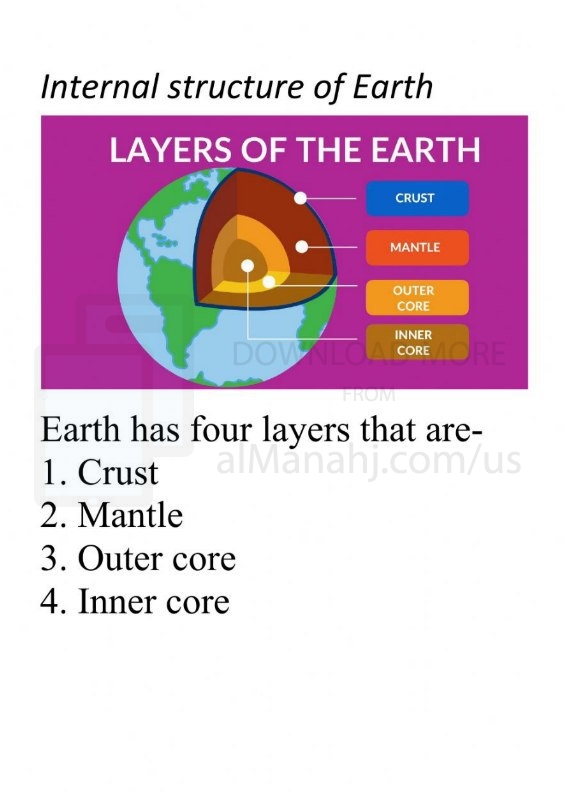| You are here: Almanahj Website ⇒ American curriculum ⇒ 9th Grade ⇒ Geology ⇒ Term 1 | ||
|---|---|---|
Worksheet about Internal structure of Earth | ||
|---|---|---|
| Subject: Geology | ||
| 9th Grade | ||
| Term 1 | ||
| Year: 2023/2024 | ||
| Size: 518.4KB | ||
| Number of clicks: 214 | ||
| Publish date:December 04, 2023 | ||
| Added by: Eman | ||
| Last download date: 2024-09-13 07:46:47 | By: theodor shibu ghimire | |
| File info: The Earth's internal structure can be divided into several layers based on their composition and physical properties. From the outermost layer to the innermost, the Earth can be divided into the following layers: 1. Crust: The crust is the outermost layer of the Earth and is composed primarily of solid rock. It is the thinnest layer, ranging from about 5 to 70 kilometers (3 to 44 miles) in thickness. The Earth's crust is divided into two types: the continental crust, which forms the continents and has a lower density, and the oceanic crust, which underlies the ocean basins and is denser than the continental crust. 2. Mantle: The mantle is the layer beneath the crust and extends to a depth of about 2,900 kilometers (1,800 miles). It is composed mainly of solid rock, although it can exhibit some semi-fluid behavior over long time scales. The mantle is divided into two parts: the upper mantle and the lower mantle. The upper mantle is relatively rigid, while the lower mantle is subjected to high pressures and temperatures, causing it to flow slowly. 3. Outer Core: The outer core is a liquid layer that surrounds the solid inner core. It extends from a depth of about 2,900 to 5,150 kilometers (1,800 to 3,200 miles). The outer core is primarily composed of molten iron and nickel. The flow of molten material in the outer core generates electric currents, which produce Earth's magnetic field through a phenomenon called the geodynamo effect. 4. Inner Core: The inner core is the innermost layer of the Earth, located at the very center. It has a radius of about 1,220 kilometers (758 miles). Despite its extremely high temperature, estimated to be around 5,500 to 6,000 degrees Celsius (9,932 to 10,832 degrees Fahrenheit), the inner core remains solid due to the extreme pressure exerted on it. It is composed mainly of solid iron and nickel. The boundary between the crust and mantle is known as the Moho discontinuity, while the boundary between the mantle and outer core is called the core-mantle boundary. Our understanding of the Earth's internal structure comes from various sources of evidence, including seismic waves generated by earthquakes, laboratory experiments, and studies of Earth's gravity and magnetic field. These data help scientists infer the composition and properties of the Earth's deep interior. It's important to note that while scientists have made significant progress in understanding the Earth's internal structure, there are still many aspects that remain the subject of ongoing research and investigation. | ||
| Downloading link Worksheet about Internal structure of Earth |
|---|
|
1701670347.pdf
The file is being prepared for download
|
| File images |
|---|
 |